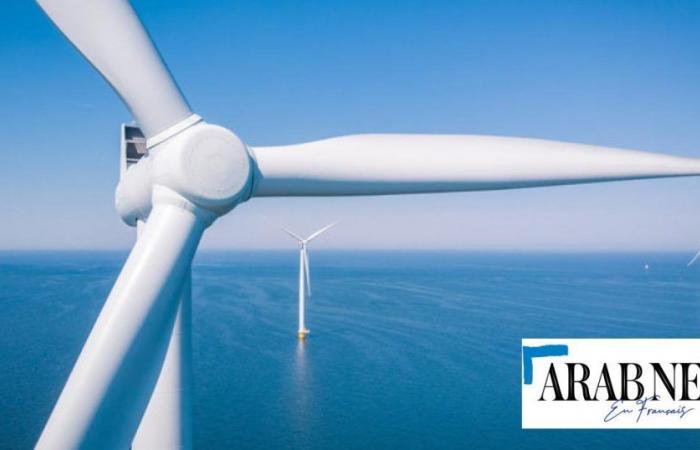RIYADH: Analysis reveals that significant investments are needed to harness the potential of 1,400 gigawatts (GW) of offshore wind power in the Middle East and North Africa (Mena).
In its latest report, the Global Wind Energy Council (GWEC) indicates that Saudi Arabia, Morocco, Egypt and Oman could pave the way for the development of this sector, which is still only in its early stages. its beginnings, with the region’s offshore activities being mainly linked to oil and gas.
This mode of electricity production is considered crucial in the energy transition process. Indeed, offshore wind power is good for the environment because it produces electricity without burning fuel or emitting carbon dioxide.
In addition, the wind at sea is stronger, more regular and less turbulent than on land, allowing energy to be produced reliably.
“The significant potential of offshore wind energy means it can (and should) be developed in the Middle East. However, this is highly dependent on the investment environment, national regulations and licensing procedures, as well as the availability of skilled labor with experience in this sector. says the GWEC report.
The paper adds that the Middle East has yet to see a major development in offshore wind power generation due to the massive investments required and readily available onshore sites.
“However, trends are changing in the Middle East. Efforts to diversify energy sources, the potential establishment of submarine links with Europe and the potential to export energy and green products could encourage countries in the Mena region to reconsider their initial position on offshore wind energy,” continues the GWEC.
Saudi Arabia will become a key player
In its report, GWEC projects that Saudi Arabia will have an overall offshore capacity of 106 GW along its eastern and western coasts.
The analysis also notes that Saudi Arabia’s growing focus on renewable energy sources will catalyze the growth of wind energy production in the future.
“The oil-rich Kingdom currently has only one onshore wind farm in operation (Dumat al-Djandal), but it is considering ambitious renewable energy projects. By 2030, the country aims to generate half of its energy supply from renewable energy sources and achieve net zero emissions by 2060,” says GWEC.
According to the report, Saudi Arabia’s renewable energy objectives, combined with the planning of large green hydrogen projects and the desire to export clean products, should favor the development of onshore wind projects and sailors.
Morocco considers offshore wind projects
According to GWEC, the Moroccan government is seriously considering establishing offshore wind projects, as the country relies heavily on energy imports, with more than 91% of its electricity coming from external sources.
Additionally, the Moroccan government has made considerable progress in the field of renewable energy and has set a goal of producing 51% of electricity from green sources by the end of the decade.
“Although there are no targets set for the development of offshore wind energy, the government is taking serious steps to consider the possibility of using this technology in the region,” GWEC points out.
Furthermore, the European Investment Bank recently granted the Moroccan Agency for Sustainable Energy a subsidy of 2 billion dollars (1 dollar = 0.94 euros) to carry out a feasibility study on the offshore wind energy in Morocco.
A previous study carried out by GWEC estimated Morocco’s offshore wind potential at 200 GW.
Global outlook
According to the report, the industry connected 10.8 GW of offshore wind turbines to the grid in 2023, representing a 24% year-on-year increase, bringing the total capacity to 75.2 GW globally.
For the sixth year in a row, China leads the annual development of offshore wind, with 6.3 GW added last year.
On the other hand, Europe added 3.8 GW of offshore wind capacity with eleven wind farms commissioned in seven markets, accounting for the majority of the new capacity.
In North America, however, wind turbines were installed in two large-scale offshore wind projects in the United States before the end of last year, but no turbines were commissioned in 2024.
The report also states that the offshore wind energy sector will experience an average annual growth rate of 25% until 2028 and 15% until the early 2030s.
GWEC Market Intelligence specifies that at least 410 GW of offshore wind capacity will be added between 2024 and 2033, with more than two-thirds expected to be added during the second half of this forecast period.
“The growth of the offshore wind sector is now much more than a European, Chinese or American story. This global industry must now “chart a path” for the tremendous growth that lies ahead,” says Rebecca Williams, Head of Offshore Wind Strategy at GWEC.
“It is worth noting that the offshore wind sector and its partners in governments, institutions and civil society are coming together and building momentum in anticipation of the imminent growth of the sector and its importance as a clean energy technology,” she emphasizes.
The report reveals that the number of members of the Global Offshore Wind Alliance, a diplomatic and multi-stakeholder initiative founded by GWEC, the International Renewable Energy Agency and Denmark, now exceeds twenty countries.
The GWEC notes that these twenty countries have committed to working together to install 380 GW of offshore wind turbines by 2030 and 2,000 GW by 2050.
“The GWEC finds that there is widespread recognition among industry and governments that the key drivers of the offshore wind sector are now in place, from government commitments, to sustainable economic growth, to increased consumer demand or the decarbonization of industry,” observes Ms. Williams.
Finally, the report highlights the progress made by different countries in the offshore wind energy sector.
In Brazil, this type of energy is considered the clean energy source of the future for its heavy industry, while in the Philippines, the government is adopting offshore wind to meet rapid growth in domestic demand and the sustainable economic development program.
“For Poland, offshore wind represents a way to stimulate industrial growth. Ireland, for its part, has set out an ambitious future framework for the growth of this sector,” says Rebecca Williams.
This text is the translation of an article published on Arabnews.com






